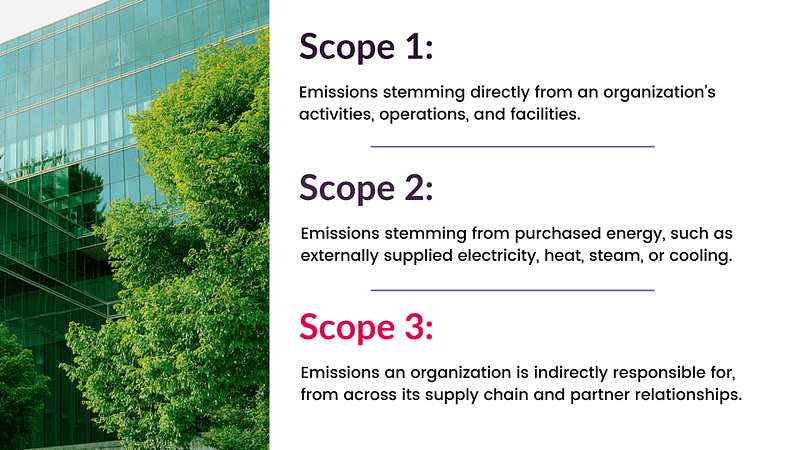On the path to sustainability, many firms diligently reduce Scope 1 and 2 emissions, but if companies overlook Scope 3 emissions – which many do – they are not looking at the full picture of their environmental impact. Often hidden in a complex web of supply chains, Scope 3 emissions are a substantial but often underestimated part of a company’s carbon footprint. Let’s explore the importance of Scope 3 emissions in addressing sustainability goals and outline how companies can collaborate with partners to mitigate their impact.
The Significance of Scope 3 Emissions
Scope 3 emissions, also known as indirect emissions, often constitute the lion’s share of a company’s carbon footprint. On average, Scope 3 emissions account for 75 percent of a company’s greenhouse gas (GHG) emissions, according to the CDP. So, for businesses looking to become greener, Scope 3 emissions is the highest impact area to start.

Reducing Scope 3 Emissions: A Collaborative Approach
Given the undeniable importance of effectively addressing Scope 3 emissions, companies must engage their partners and supply chains to address sustainability goals effectively. Here are strategies and case studies demonstrating how this collaboration can yield positive outcomes:
- Supplier Engagement: Collaborating with suppliers to reduce emissions is a critical step. For instance, Apple’s Supplier Clean Energy Program has helped suppliers transition to 100% renewable energy sources. As of March 2022, 213 of their suppliers had committed to using 100% renewable energy for Apple production. In FY 2021, thanks to the clean energy generated by suppliers, Apple prevented 13.9 million metric tons of carbon emissions.
- Product Design and Innovation: Companies can work with suppliers to design more sustainable products. Nike’s Flyknit fabric, developed in collaboration with suppliers and made from plastic bottles, reduces waste by 60% compared to traditional footwear manufacturing methods.
- Transparency and Reporting: Implementing transparency initiatives, like the Carbon Disclosure Project (CDP), encourages suppliers to measure, manage, and disclose their emissions. This incentivizes responsible practices across the supply chain.
- Setting Emission Reduction Targets: Collaboratively setting emissions reduction targets with partners can drive meaningful change. For instance, Unilever’s Sustainable Living Plan includes commitments to achieve net-zero emissions across its value chain by 2039.
- Circular Economy Practices: Embracing circular economy principles can reduce waste and emissions. Dell has successfully implemented a closed-loop recycling program for electronic products. Through their recycling programs, Dell takes plastics from old computers and creates plastic parts for new computers. Each year, Dell uses over 10 million pounds of recycled plastics in their products, about 4 million pounds of which is sourced from their collection of used electronics.
- Supplier Audits and Certifications: Conducting supplier audits and encouraging certifications, such as ISO 14001 (Environmental Management System), can ensure environmental standards are met. Walmart’s Project Gigaton encourages suppliers to undergo sustainability assessments and reduce emissions.
5 Steps to Tackle Scope 3 Emissions
As you can see, Scope 3 emissions are an important element of a company’s overall carbon footprint, one that needs to be addressed. Additionally, addressing Scope 3 emissions can lead to excellent business outcomes and impressive progress on the road to sustainability. Here are five actionable steps you can take to start tackling your firm’s Scope 3 emissions.
- Conducting a comprehensive Scope 3 emissions assessment is a great first step to reducing your company’s Scope 3 emissions. Identify the most significant sources and categories within your supply chain. This assessment will help you prioritize your emissions reduction efforts.
- Engage with suppliers and partners to gather data on their emissions and work together on reduction strategies.
- Establish clear emissions reduction targets with suppliers and partners.
- Integrate sustainability criteria into procurement decisions.
- Continuously measure and report your progress on tackling Scope 3 emissions to your stakeholders. This will help foster a sustainable, accountable culture in your organization and value chain.
By engaging with partners, setting clear and ambitious targets, conducting a comprehensive Scope 3 emissions assessment, and embracing sustainable practices, companies can reduce their Scope 3 emissions and create a more sustainable and resilient future. In this era of increasing environmental awareness, effective collaboration along the supply chain is a necessity for any company committed to sustainability.
Our Scope 3 decarbonization platform, CarbonDetect, can help you improve your Scope 3 emissions score and pinpoint where to reduce your carbon footprint. Learn more.


